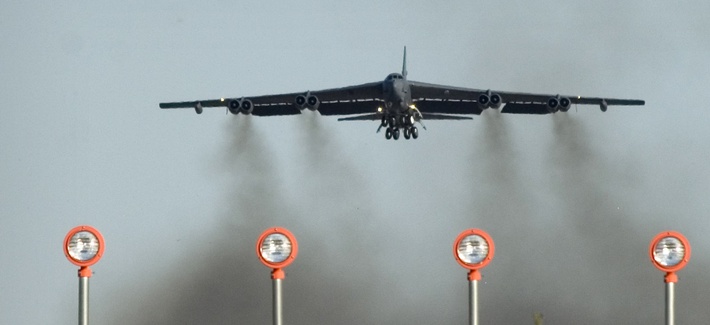Loading...
BY MICHAEL KREPON
 The arms-control diplomacy passages of the draft Nuclear Posture Review have drawn little attention, likely because little change was expected in this aspect of policy. Nevertheless, words matter here, especially when they seek to establish conditions that are extremely dangerous or that foreclose any future compacts. The Trump administration’s draft document would do precisely this by calling for any future agreements limiting and reducing nuclear dangers to be “enforceable.” The relevant passage of the pre-decisional draft is, “The United States is committed to arms control efforts that advance U.S., allied, and partner security; are verifiable and enforceable.”
The arms-control diplomacy passages of the draft Nuclear Posture Review have drawn little attention, likely because little change was expected in this aspect of policy. Nevertheless, words matter here, especially when they seek to establish conditions that are extremely dangerous or that foreclose any future compacts. The Trump administration’s draft document would do precisely this by calling for any future agreements limiting and reducing nuclear dangers to be “enforceable.” The relevant passage of the pre-decisional draft is, “The United States is committed to arms control efforts that advance U.S., allied, and partner security; are verifiable and enforceable.”Verifiable agreements? Yes, absolutely. That’s how we’ve gotten to reduce U.S. and Russian strategic forces by 85 percent from Cold War-era highs. Enforceable nuclear arms control? That’s novel. Enforceable arms control requires a prostrate adversary, or world government, or a United Nations with strong enough powers of enforcement because permanent members of its Security Council have given up their veto powers and contributed to large standing armies carrying out joint operations flying the UN flag.
Not going to happen? Well, there’s another option: war and occupation. If someone cheats on an agreement and diplomacy and sanctions fail to rectify the situation, what other enforcement options does the aggrieved party have?
The last time the enforcement option was seriously employed was after World War I on defeated Germany. As part of the punitive Versailles Treaty’s provisions, Germany was forced to pay reparations, the Rhineland was demilitarized and occupied by foreign inspectors, the size of the German Army and the tonnage of its capital ships were strictly limited, submarine construction was prohibited, as was the creation of a German Air Force. These enforcement provisions didn’t go very well. The reparations dried up, the occupiers went home, and German armament factories resumed business in preparation for World War II.
No treaty to reduce nuclear dangers and forces contains the word “enforcement.” All of the progress that has been made to date has been accomplished without enforcement mechanisms. Verification and treaty monitoring became the substitutes for enforcement in the nuclear age. Sophisticated monitoring capabilities allowed parties to determine if violations were occurring in time to take corrective action.
Treaties also included provisions to deal with compliance issues, including on-site inspections and consultative mechanisms. If disputes could not be resolved, the aggrieved state could take complaints to the UN Security Council, knowing full well the difficulties of securing unanimous consent among veto-wielding members. Or instead of going the UN route, the aggrieved state could take compensatory actions to regain any perceived loss of security, which might or might not include walking away from the treaty.
These provisions were messy, no doubt, and certainly less than satisfactory. But this is how the nuclear safety net was woven over the past fifty years, a safety net that limited nuclear proliferation, produced deep cuts in nuclear forces, established norms against nuclear testing and the battlefield use of nuclear weapons. This is why most of us cannot remember seeing a mushroom cloud or experiencing the horror of trying to figure out how to contact loved ones in the fifteen minutes left after a missile launch warning, before the bomb arrives.
As messy as diplomacy is to reduce nuclear dangers, it’s not as messy as enforcement by means of war and occupation. So what is the Trump administration thinking when it makes enforcement a requirement of new agreements? The United States will not accept foreign enforcement of limits on U.S. nuclear capabilities. Russia and China will not accept U.S. enforcement on limits of their nuclear capabilities. War and occupation aren’t options here.
What, then, constitutes enforcement in the nuclear age? One definition of enforcement is unilateral action. Enforcement can mean pre-emptive strikes against facilities capable of producing dangerous weapons and material. More ambitiously and recklessly, enforcement can mean preventive war. Enforcement can be arms control by other means when diplomacy fails, or isn’t seriously tried. Or enforcement can be a substitute for diplomacy. When practiced against weak states at the front end of their nuclear ambitions, enforcement can mean something more manageable than full-scale war and occupation along the German model after World War I.
Is this what the Trump administration’s draft nuclear posture review means when it speaks of enforcement? What would enforcement look like when applied to North Korea, which hasn’t agreed to nuclear constraints, or to Iran, which has? If the Trump administration is going to make enforcement central to its conception of arms control, it has much explaining to do.

Michael Krepon is co-founder of the Stimson Center and author of "Better S
Loading...
No responses yet for "The Most Dangerous Word in the Draft Nuclear Posture Review"
Post a Comment